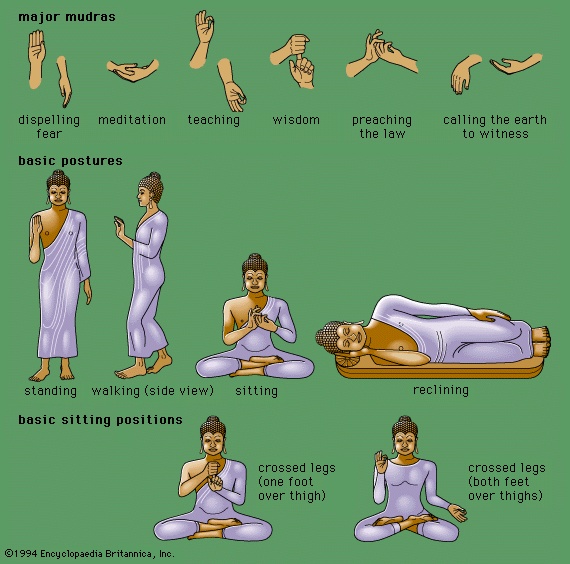mudra
symbolic gestures
Sanskrit Mudrā
(“seal,” “mark,” or “gesture”), in Buddhism and Hinduism, a symbolic gesture of the hands and fingers used either in ceremonies and dance or in sculpture and painting. Mudras used in ceremony and dance tend to be numerous, complicated, and often esoteric (the hasta-mudrās of Hindu classical dance can express about 500 different meanings, involving not only the hands and fingers but also the wrists, elbows, and shoulders, all in movement). Mudras in sculpture and other visual arts, being necessarily immobile, are relatively restricted in number.
In ceremonies, especially in Buddhism, a mudra acts as a kind of visual “seal,” affirming a mystical or magical vow or utterance, such as a supplication to ward off evil. A mudra often accompanies the spiritual utterance known as the mantra (q.v.).
 Sculptural and other pictorial renderings of the Buddha show him in four basic postures—reclining, standing, walking, and sitting. The two most traditional seated postures are the vīrāsana posture (the right leg bent and positioned over the left leg) and the vajrāsana posture (the legs tightly crossed so that the soles of both feet are visible, the feet sometimes resting on the opposing thighs). Different mudras, or hand gestures, may appear in any of the postures. (The accompanying figure-->
Sculptural and other pictorial renderings of the Buddha show him in four basic postures—reclining, standing, walking, and sitting. The two most traditional seated postures are the vīrāsana posture (the right leg bent and positioned over the left leg) and the vajrāsana posture (the legs tightly crossed so that the soles of both feet are visible, the feet sometimes resting on the opposing thighs). Different mudras, or hand gestures, may appear in any of the postures. (The accompanying figure--> illustrates some of the major mudras.) Although pictorial mudras are used most commonly in portraying the Buddha, they can also appear in representations of lesser personages. The añjali (“reverence”) mudra, for example, which has the suppliant or worshiper joining his two hands before him, palm to palm, slightly cupped, in a gesture of respectful adoration (comparable to the Western gesture of prayer), would appear only in representations of deities or persons other than the Buddha; it would never be shown for the Buddha.
illustrates some of the major mudras.) Although pictorial mudras are used most commonly in portraying the Buddha, they can also appear in representations of lesser personages. The añjali (“reverence”) mudra, for example, which has the suppliant or worshiper joining his two hands before him, palm to palm, slightly cupped, in a gesture of respectful adoration (comparable to the Western gesture of prayer), would appear only in representations of deities or persons other than the Buddha; it would never be shown for the Buddha.The hundreds of mudras of Hindu and other related Asian dances are described in technical manuals, but, in practice, performers usually limit their gestures or “phrases” (sequences of mudras) to those familiar and meaningful to their audiences. The selection may differ from region to region.
- Kasanje
- Kasaoka
- Kasavubu, Joseph
- kasb
- Kaschnitz, Marie Luise
- kashf
- Kashgar
- Kashgar rug
- Kashihara
- Kashiwa
- Kashiwazaki
- Kashkadarya
- Kashmir
- Kashmir earthquake
- Kashmiri language
- kashmir shawl
- Kashmir, Vale of
- Kashmir Śaivism
- kashruth
- Kashta
- Kasimir Fajans
- Kasimir Felix Badeni, Graf von
- Kasimir Felix, Graf von Badeni
- Kasimovian Stage
- Kaska